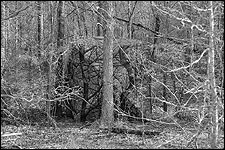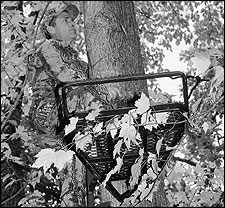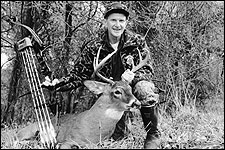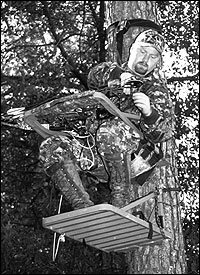October 28, 2010
By Bob Poth
Stands That Are Almost Good Enough Can Keep You Stuck In The Wrong Place
By Bob Poth
 Moving from an already "prepared" stand site to a location not so hospitable can be a pain. In some cases, a quality portable blind that goes up and down quickly and easily, like this ICE Blind from Double Bull Archery, is clearly the only way to go. |
When it comes to tree stand location, some bowhunters are slow learners, or maybe just living examples of the adage that old habits die hard. We've read the books and articles that encourage scouting during the late-winter months after the season and again in late summer before the new season begins. These are sound practices, but many of us select tree stand locations during preseason scouting and then stay with those locations as long as we are seeing deer, even if at long distances. We reason that it is just a matter of time before one of those deer will pass within bow range. Sometimes we find ourselves in the wrong location because we have keyed-in on the wrong food sources; in other cases, the preferred or available food sources may have changed as the season progressed.
For example, during the 1997 season, I had a stand in the bottom of a draw where a woodlot opened onto a marshy bottom bordered by cornfields. There were several trails that led past the stand into the bottom. The corn was obviously a drawing card for the local deer herd. I almost always saw deer from this stand and even harvested a doe early in the season. However, almost every time I hunted the stand during October, I saw several deer, including two different bucks, feeding on acorns under a stand of oaks about 60 yards up the draw. Still, I stuck with the stand site, believing that the next time I hunted the stand those bucks would move past my me on their way to the cornfields beyond. They never did! It was as if the deer themselves were telling me where my stand needed to be positioned, but I wasn't smart enough to listen.
Advertisement
GETTING WITHIN RANGE
While many stand sites seem productive, often they lie out of range of moving deer. Even though you may occasionally take a deer from one of these sites, it is usually a situation of being frustrated by watching at a distance as deer, and sometimes good bucks, pass safely by out of range. While seeing deer is fun and keeps you coming back for another try, the goal is to get within range. Flexibility is the key when choosing and hunting your stand sites. The successful hunter needs to view stand locations as temporary, carefully watch what the deer are doing and know when and be willing to move.
When I began scouting the 1998 season, I was very determined to make good stand site selections. As I looked over the farm with the corn-bordered brushy bottom mentioned earlier, all the sign pointed to the same tree as last year. It's almost like I couldn't help myself; I was convinced that this year that stand would be hot! Wouldn't you know, the first afternoon that I hunted the stand, I sat helplessly and watched not one, but three bucks feed for over half an hour under those same oaks 60 yards above me. I had chosen the location because of the corn, but acorns were the real attractant. That did it! I was not going to repeat my mistake of last year. I was finally going to listen to what the deer were telling me.
Advertisement
 During scouting forays, bowhunters often make the mistake of putting up tree stands without taking into account changing deer patterns. Deer often shift to different food supplies, requiring the bowhunter who wants success to move his stand. |
The stand was relocated the next day to a position 50 yards up the draw among the oaks and then rested for several days. The very next opportunity to hunt that stand, I arrowed a fat six-pointer at less than 20 yards as he arrived to feed on the acorns littering the ground around the stand. I was able to take that buck because of the decision to finally relocate the stand near the deer's primary food source. I was excited; taking that deer reinforced the move.
WHITETAIL LOGIC
It was beginning to become obvious that there was more to this fine-tuning than simply moving a stand to a location where deer have been sighted. There must be a logical reason for the deer to be moving through or using another area to warrant stand relocation. It was the presence of a primary food source, in this case, a grove of oaks dropping acorns. This is easy to understand, but what about situations where deer may be seen consistently moving through a specific area out of range of your stand but where food does not seem to be a factor?
Interestingly, the oak grove stand "dried up" several weeks later, with no deer coming into the area. However, deer could be observed from the stand 100 yards above the oak grove browsing and moving about in an area of thick cover at the head of the draw. This was a similar situation to what I was experiencing while hunting the farmland immediately surrounding my home. Several small bucks were chasing does under a stand located just inside the edge of a long, brushy creek bottom on two consecutive evenings. There were several larger bucks in the area, and on both of those evenings, other bucks could be heard and glimpsed aggressively pursuing does in the midst of the thick, brushy bottom.
Once again, preplaced tree stands were not quite where they needed to be. The deer were in sight but out of range. However, in neither case did food appear to be a factor. What were the deer saying this time? The key factor in both of these situations was the thick, brushy cover the deer seemed to be using. The deer and particularly the larger bucks were telling any observant hunter that they preferred the security of the thick cover, not venturing through the open areas until after dark.
Hunting pressure as the season progresses affects these shifts in deer movement and habits. Regardless of how careful we try to be in entering and leaving our stand areas, deer can, and do, pattern us and our movement in the field just as we attempt to pattern their movements. Bowhunters must be mobile and ready to follow where the deer lead.
 The author bagged this 10-point buck after realizing he needed to change his stand location to accommodate current deer patterns. It's always fun to view deer from a distance, but seeing them up close is clearly the most satisfying and much more conducive to successful bowhunting. |
Both of the stands were moved to strategic positions within the thick cover. One to the head of the
draw where I took a nice doe as she browsed through the second growth and greenbrier. The other was relocated to a large maple in the center of the brushy bottom overlooking two well-used trails. While visibility was limited in the thick cover, I knew the stand was in the right place.
I had deer all around me the first evening I hunted the stand, but failing light didn't allow a shot. Several days later, I hunted this stand again during an early November morning. Having entered the stand before daylight, deer could be heard moving and chasing each other in the bottom just downstream from the stand. They were close, and when a breeze began gently blowing up the bottom, the strong smell of rutting deer was heavy in the air. At 7:20 a.m., just after daylight, I arrowed a fine 10-point buck as he moved past my stand.
BE PREPARED TO MOVE
Sometimes our reluctance to move a stand is due to the fact that a suitable tree for the type of stand we use doesn't seem to be available in the "right" spot. This can be a problem, particularly for climbing stands. That is why it is important to have the flexibility of at least one hang-on stand with a portable ladder system or steps that you can use when a straight, clean tree isn't available for your climber. However, there can be times when there simply is not a suitable tree for any type of elevated stand available where you need to move. In these situations, as bowhunters we need to turn the clock back a few decades to before we taught deer to look up. We need to revisit the ground blind. There is a whole new generation of very portable and effective ground blinds being introduced today.
 There are two great options for keeping mobile when hunting from a tree stand. The easiest is, of course, a climbing stand whenever the local vegetation will allow. The second is a tree stand that comes with a mounting bracket. Several brackets are hung in different locations, and the stand can then be transported and hung--quickly and quietly. |
Fine-tuning may be necessary throughout the season as you periodically hunt your stands. Deer movement will change as the season progresses as a result of factors such as depleted food sources, changing agricultural practices and increased hunting pressure. So, throughout the season continue to be alert to changes in deer movement; they may be telling you something.
Sure, it takes extra time and effort to relocate your stands. By reacting quickly and relocating my stands to positions where I saw dee,r and could see a logical reason for why they were there, enabled me to take three deer this past year, including my best buck of the season. I've learned my lesson. If you are regularly seeing deer some distance from your stand site, listen to what they are saying to you; it may be time to fine-tune your stand placement. It pays off in whitetail dividends!
